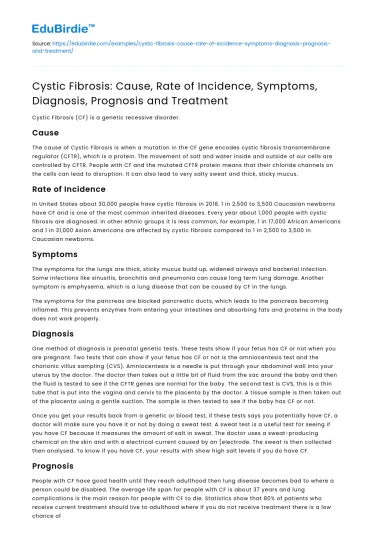Cystic Fibrosis (CF) is a genetic recessive disorder.
Cause
The cause of Cystic Fibrosis is when a mutation in the CF gene encodes cystic fibrosis transmembrane regulator (CFTR), which is a protein. The movement of salt and water inside and outside of our cells are controlled by CFTR. People with CF and the mutated CFTR protein means that their chloride channels on the cells can lead to disruption. It can also lead to very salty sweat and thick, sticky mucus.
Rate of Incidence
In United States about 30,000 people have cystic fibrosis in 2018. 1 in 2,500 to 3,500 Caucasian newborns have CF and is one of the most common inherited diseases. Every year about 1,000 people with cystic fibrosis are diagnosed. In other ethnic groups it is less common, for example, 1 in 17,000 African Americans and 1 in 31,000 Asian Americans are affected by cystic fibrosis compared to 1 in 2,500 to 3,500 in Caucasian newborns.
Symptoms
The symptoms for the lungs are thick, sticky mucus build up, widened airways and bacterial infection. Some infections like sinusitis, bronchitis and pneumonia can cause long term lung damage. Another symptom is emphysema, which is a lung disease that can be caused by CF in the lungs.
The symptoms for the pancreas are blocked pancreatic ducts, which leads to the pancreas becoming inflamed. This prevents enzymes from entering your intestines and absorbing fats and proteins in the body does not work properly.
Diagnosis
One method of diagnosis is prenatal genetic tests. These tests show if your fetus has CF or not when you are pregnant. Two tests that can show if your fetus has CF or not is the amniocentesis test and the chorionic villus sampling (CVS). Amniocentesis is a needle is put through your abdominal wall into your uterus by the doctor. The doctor then takes out a little bit of fluid from the sac around the baby and then the fluid is tested to see if the CFTR genes are normal for the baby. The second test is CVS, this is a thin tube that is put into the vagina and cervix to the placenta by the doctor. A tissue sample is then taken out of the placenta using a gentle suction. The sample is then tested to see if the baby has CF or not.
Once you get your results back from a genetic or blood test, if these tests says you potentially have CF, a doctor will make sure you have it or not by doing a sweat test. A sweat test is a useful test for seeing if you have CF because it measures the amount of salt in sweat. The doctor uses a sweat-producing chemical on the skin and with a electrical current caused by an [electrode. The sweat is then collected then analysed. To know if you have CF, your results with show high salt levels if you do have CF.
Prognosis
People with CF have good health until they reach adulthood then lung disease becomes bad to where a person could be disabled. The average life span for people with CF is about 37 years and lung complications is the main reason for people with CF to die. Statistics show that 80% of patients who receive current treatment should live to adulthood where if you do not receive treatment there is a low chance of living to adulthood.
Current Treatments
The transfer of copies of the normal CFTR gene to the relevant cells is Gene therapy. This should work because it is a single gene disorder, the airways are easily accessible and at birth the lungs are normal. A problem with gene therapy is that the airways are very difficult to target. This is because the mucociilary escalator keeps foreign particles out. Another problem is the immune response for viral and non-viral gene transfer agents because for viral gene transfer agents the issue is re-administration and for non-viral gene transfer agents it is an inflammatory response.
Lung transplantation is an option when a person with CF is having breathing problems, increasing resistance to antibiotics and lung complications. Having both lungs replaced will help get rid of bronchiectasis, which is the widening of the air ways, but it does not get rid of the other issues like sinus infections and pancreas problems.
Future Treatments
An antifungal drug called amphotericin was found using human cells and animals’ models. This antifungal drug helps lung cells function easier for patients to fight chronic bacterial lung infections. This drug is more effective than the other treatments because this drug work with any mutation even when the protein is not there.






 Stuck on your essay?
Stuck on your essay?

